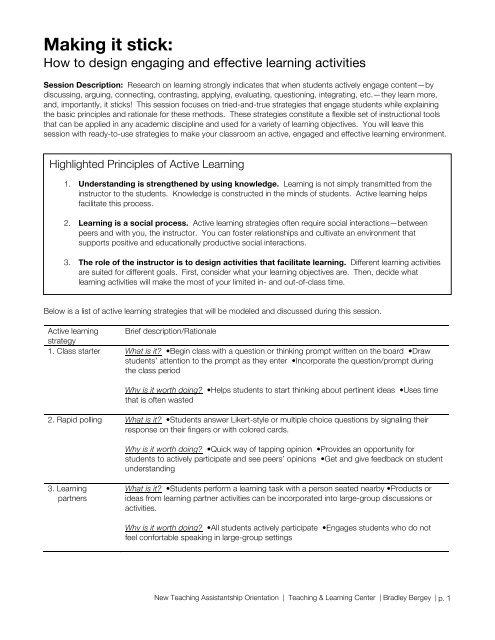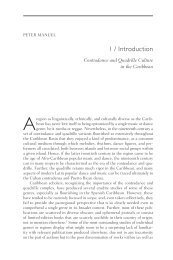Session Handout-Active Learning Principles and Strategies
Session Handout-Active Learning Principles and Strategies
Session Handout-Active Learning Principles and Strategies
You also want an ePaper? Increase the reach of your titles
YUMPU automatically turns print PDFs into web optimized ePapers that Google loves.
Making it stick:<br />
How to design engaging <strong>and</strong> effective learning activities<br />
<strong>Session</strong> Description: Research on learning strongly indicates that when students actively engage content—by<br />
discussing, arguing, connecting, contrasting, applying, evaluating, questioning, integrating, etc.—they learn more,<br />
<strong>and</strong>, importantly, it sticks! This session focuses on tried-<strong>and</strong>-true strategies that engage students while explaining<br />
the basic principles <strong>and</strong> rationale for these methods. These strategies constitute a flexible set of instructional tools<br />
that can be applied in any academic discipline <strong>and</strong> used for a variety of learning objectives. You will leave this<br />
session with ready-to-use strategies to make your classroom an active, engaged <strong>and</strong> effective learning environment.<br />
Highlighted <strong>Principles</strong> of <strong>Active</strong> <strong>Learning</strong><br />
1. Underst<strong>and</strong>ing is strengthened by using knowledge. <strong>Learning</strong> is not simply transmitted from the<br />
instructor to the students. Knowledge is constructed in the minds of students. <strong>Active</strong> learning helps<br />
facilitate this process.<br />
2. <strong>Learning</strong> is a social process. <strong>Active</strong> learning strategies often require social interactions—between<br />
peers <strong>and</strong> with you, the instructor. You can foster relationships <strong>and</strong> cultivate an environment that<br />
supports positive <strong>and</strong> educationally productive social interactions.<br />
3. The role of the instructor is to design activities that facilitate learning. Different learning activities<br />
are suited for different goals. First, consider what your learning objectives are. Then, decide what<br />
learning activities will make the most of your limited in- <strong>and</strong> out-of-class time.<br />
Below is a list of active learning strategies that will be modeled <strong>and</strong> discussed during this session.<br />
<strong>Active</strong> learning Brief description/Rationale<br />
strategy<br />
1. Class starter What is it? •Begin class with a question or thinking prompt written on the board •Draw<br />
students’ attention to the prompt as they enter •Incorporate the question/prompt during<br />
the class period<br />
Why is it worth doing? •Helps students to start thinking about pertinent ideas •Uses time<br />
that is often wasted<br />
2. Rapid polling What is it? •Students answer Likert-style or multiple choice questions by signaling their<br />
response on their fingers or with colored cards.<br />
Why is it worth doing? •Quick way of tapping opinion •Provides an opportunity for<br />
students to actively participate <strong>and</strong> see peers’ opinions •Get <strong>and</strong> give feedback on student<br />
underst<strong>and</strong>ing<br />
3. <strong>Learning</strong><br />
partners<br />
What is it? •Students perform a learning task with a person seated nearby •Products or<br />
ideas from learning partner activities can be incorporated into large-group discussions or<br />
activities.<br />
Why is it worth doing? •All students actively participate •Engages students who do not<br />
feel confortable speaking in large-group settings<br />
New Teaching Assistantship Orientation | Teaching & <strong>Learning</strong> Center | Bradley Bergey | p. 1
4. Opinion<br />
spectrum<br />
What is it? •Pose a question or issue on which there will likely be varied responses<br />
•Establish poles on a spectrum (e.g., Agree/Disagree) •Students move themselves to<br />
physically represent their “stance” on the issue • Ask students to articulate their view or an<br />
opposing viewpoint<br />
Why is it worth doing? •Gets students out of their seats—can be a good break in a lecture<br />
•Can visually see differences in opinions <strong>and</strong> how opinions shift over time<br />
5. Jigsaw What is it? •Assign different readings to different students (e.g., some students read<br />
section 1, others section 2, etc.) •Students who read the same reading meet to discuss<br />
<strong>and</strong> solidify their underst<strong>and</strong>ing •Then, students are paired with others who have read<br />
different materials •Students teach each other the content<br />
Why is it worth doing? •In teaching others, students underst<strong>and</strong> <strong>and</strong> retain more<br />
•Exposes students to a greater amount of material while limiting the amount of reading for<br />
each individual student<br />
6. Quick whip What is it? •Each member of the class quickly shares a comment, idea or question.<br />
Why is it worth doing? •Everyone participates •Lots of ideas are shared quickly<br />
7. Exit slips What is it? •In the closing minutes of class, students respond to a prompt or question (e.g.,<br />
What is the stickiest/most unclear point? The main idea for today is…)<br />
Why is it worth doing? •Provides feedback on students’ underst<strong>and</strong>ing, questions, etc.<br />
•Provides opportunities for students to consolidate what was learned •If graded, exit slips<br />
provide an incentive to not leave early<br />
Also discussed during this session: •Student-created case studies •Mind maps •<strong>Learning</strong> journals •Fish-bowl<br />
discussion •10 Suggestions to improve a lecture •10 Steps when facilitating experiential activities •10 Time<br />
savers when active learning takes time •10 Interventions when students get out of h<strong>and</strong><br />
Many of these tips <strong>and</strong> activities have been taken directly or indirectly from:<br />
Silberman, M. (1996). <strong>Active</strong> learning: 101 <strong>Strategies</strong> to teach any subject. Boston, MA: Allyn & Bacon.<br />
For workshop materials, please email me at: bradley.bergey@temple.edu<br />
New Teaching Assistantship Orientation | Teaching & <strong>Learning</strong> Center | Bradley Bergey | p. 2
















